On a sunny day in June of last year, and anxious to avoid a long list of home DIY jobs, I drove a few miles over the South Downs to the village of Alfriston.* I spent an absorbing hour browsing in the book shop, peering through windows (some of them public), not going into the pub
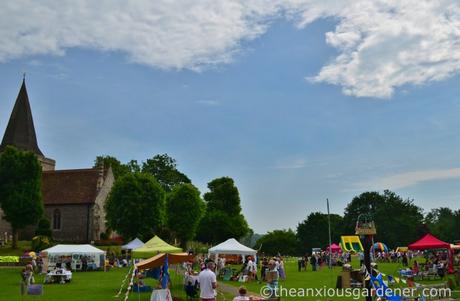
The Tye, Alfriston
and finally gravitated to the church on the Tye (or village green, if you’d rather).
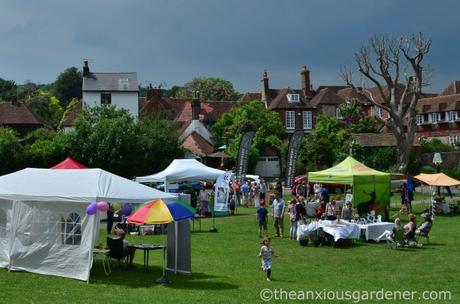
Sussex Day, Alfriston
I hadn’t realised that it was Sussex Day (I hadn’t even heard of Sussex Day) and enjoying the fete atmosphere, I circled amongst the stalls, watched a little sword fighting re-enactment (but only a little), grabbed a coffee and glancing at my watch, decided I still had plenty of spare time.
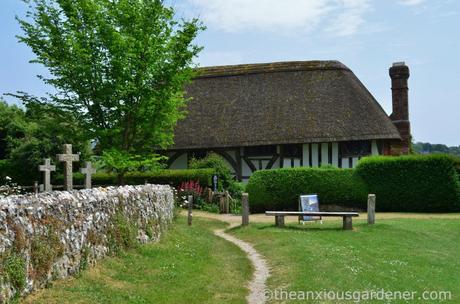
I looked across at The Clergy House next to the church and decided on a spontaneous visit. I have annual membership of the National Trust and, each year, I shamelessly wring as much value out of it as possible. The Clergy House is my local NT property and I’ve explored the garden several times over the years. But, like most gardens, it repays visits at different times of the year – and besides, I’d chalk up a £5.35 entrance fee to my tally. I fished out my dog-eared, NT card, gulped the last of my coffee and strolled over.
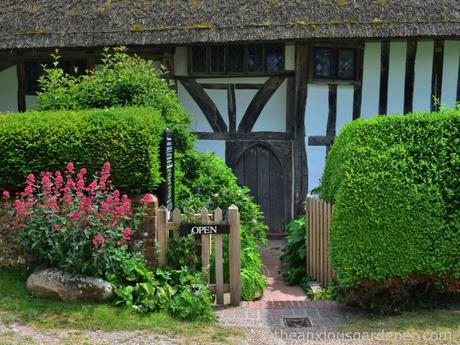
As you probably know, The Clergy House was the National Trust’s first acquisition; bought in 1896 for the mighty sum of £10.
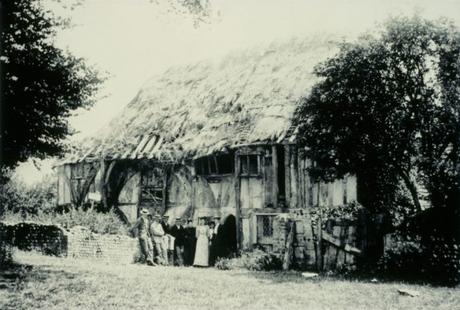
The Clergy House, 1894. National Trust image
Which given the house’s state, sounds more of a bargain than it probably was. This rare example of a medieval Wealden hall house was built in about 1350 and by the late nineteenth century was in such a state of disrepair that the owners, the Ecclesiastical Commissioners, decided to demolish it. But first they agreed that a woman, Harriet Coates – who had been born and still lived in the house – could see out her days there.
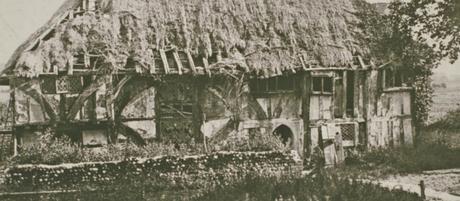
The Clergy House, 1896. National Trust image
After she died in 1888, the new vicar of Alfriston, the Rev. Beynon, sought to save the building and eventually contacted the newly formed ‘National Trust for Places of Historical Interest or Natural Beauty’. They agreed to buy and sympathetically restore their first building (many Victorian renovations were anything but sympathetic).
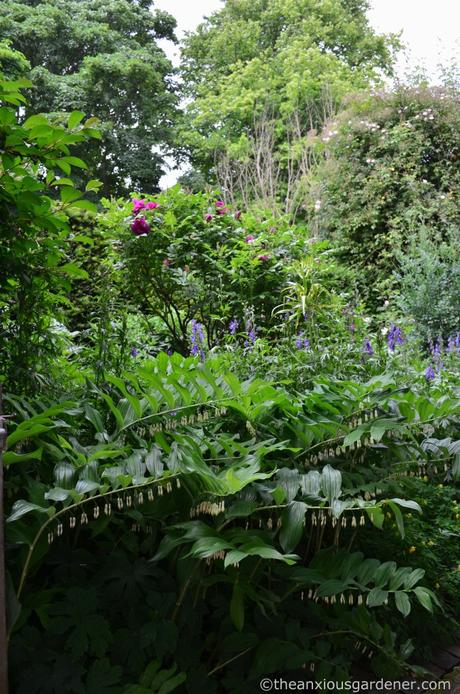
Stepping through the front gate, and before reaching the ticket office at the back of the house, I passed a large bed plumped up with Solomon’s seal (Polygonatum × hybridum). I wondered whether theirs is attacked as virulently by sawfly as mine. After writing about the scourge of Solomon’s seal sawfly (see – ‘Garden Visitors’ ), I found that picking off the grubs one year led to a dramatic decrease in numbers in subsequent years. In 2013 I collected well over a hundred, in 2016 hardly a handful and my plants no longer resemble lace-work by autumn.
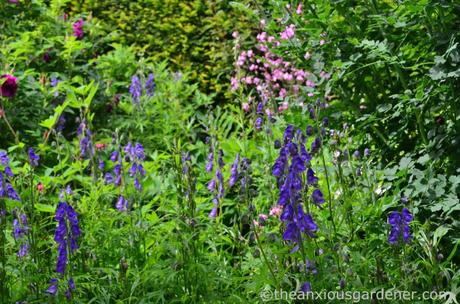
Above the Solomon’s seal rose spires of monkshood (Aconitum napellus): a plant I love despite its toxicity and one that happily flowers in shade or sun (and isn’t prey to slugs).
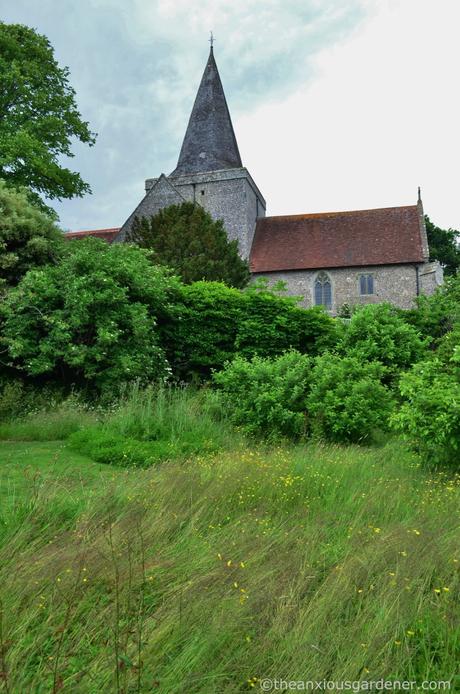
St Andrew’s Church, Alfriston – ‘The Cathedral of the South Downs’
From the ticket office, I veered off to the east (I’m making the garden sound much bigger than it is) to an area of lawn merging into uncut grass.
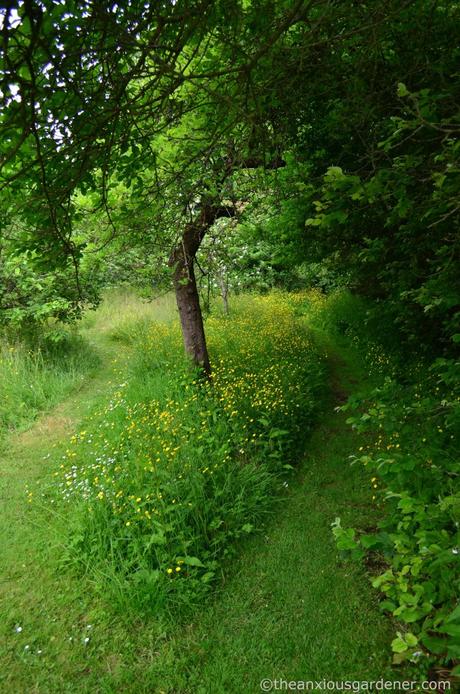
I leave similar areas un-mown in ‘my’ gardens and a simple display of buttercups and daisies gives easy reward, even without adding wild-flower plugs or bulbs.
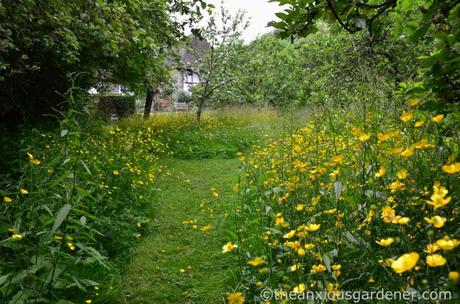
Mowing paths through the long grass makes a feature of what is, after all, unkempt lawn. More close sward or buttercups and daisies? I know which I prefer.
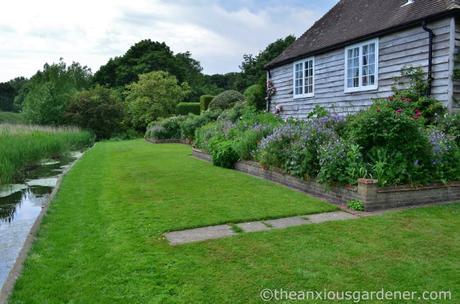
I walked along the bank of a reed-filled pond to the rear of the ticket office and towards the beds and borders near the house.
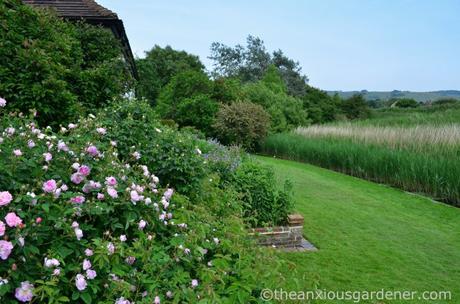
As the garden is fairly small, I paused often: studied plants, smelled roses and tried/failed to photograph small birds zipping amongst the reeds.
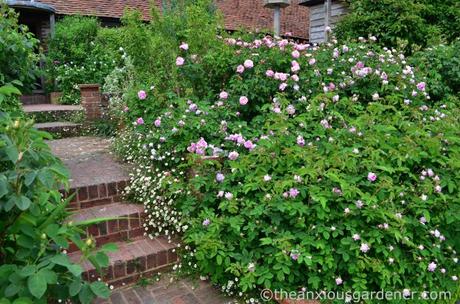
As every flight of sunny steps should, these were lined with Mexican fleabane (which trips off the tongue easier than Erigeron karvinskianus). This little wonder will flourish in the tiniest of cracks, self-seed and flower non-stop till the first frosts.
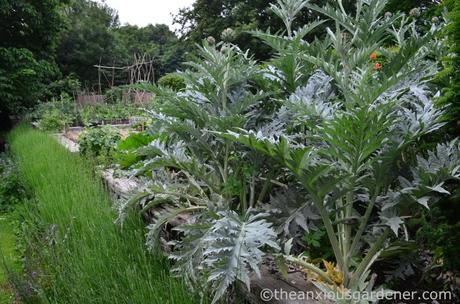
To the west of the house lies the vegetable garden and it’s impressive. Past stately artichokes;
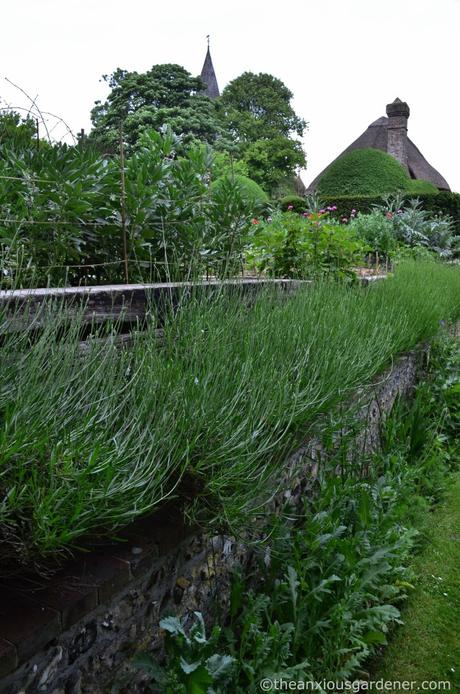
and a lavender hedge (worth another visit to see in flower);
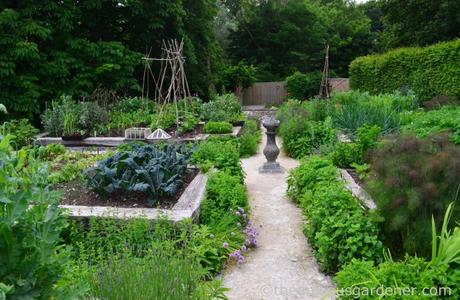
I arrived amongst the raised beds. These are seriously constructed and I winced at the inadequate, half-inch width boards I have used. Unlike mine these will last decades. (After eight years, several boards at The Priory are rotten and need replacing but I suppose eight years is quite a long time). Though still relatively early in the season, the kitchen garden was zingy green and harvest-able … but I didn’t.
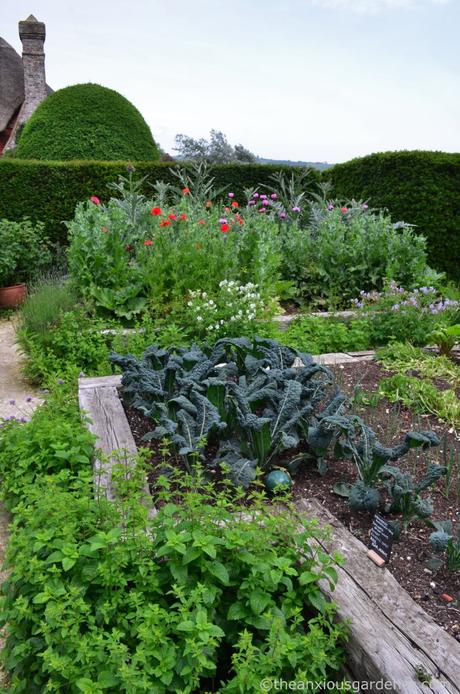
I pulled a face at memories of eradicating, fanatically, opium poppies in The Old Forge vegetable garden, in an ongoing battle to prevent it self-seeding.
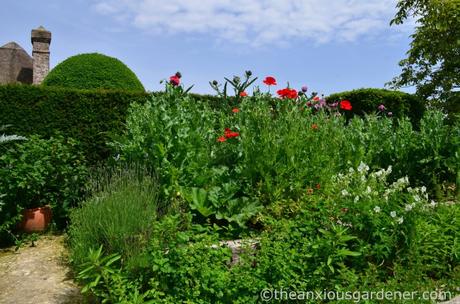
But actually, why did I do that? They add to a vegetable garden rather than detract … and are easy enough to pull up if they appear somewhere unwanted.
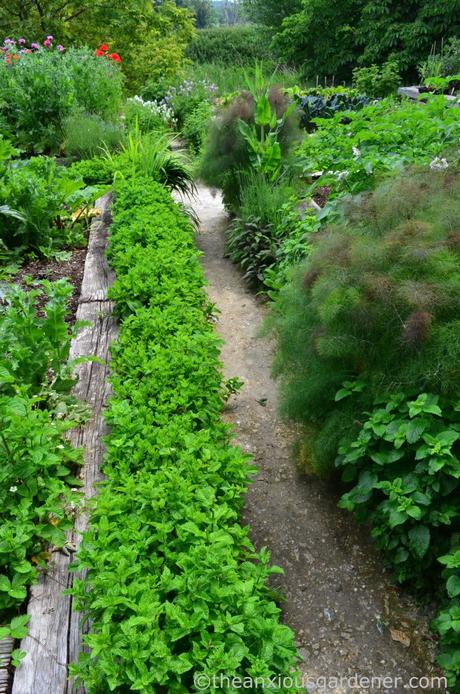
I hadn’t seen mint ‘hedges’ before and they proved impossible not to touch (and then sniff my fingers). How nice an idea is that? Mint lining a path, softening those hard, straight beds and readily available for Pimm’s O’clock?
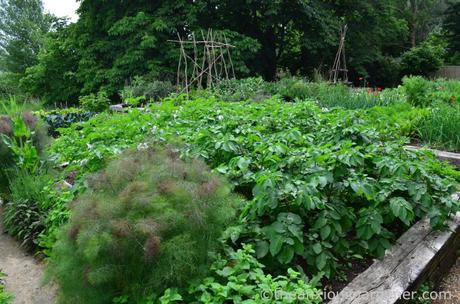
Silky bronze fennel also drew my hand, growing against burgeoning potatoes, with a nearby teasel left to flower in its own good time. I would have pulled that up too but resolved to be more relaxed about interlopers in future.
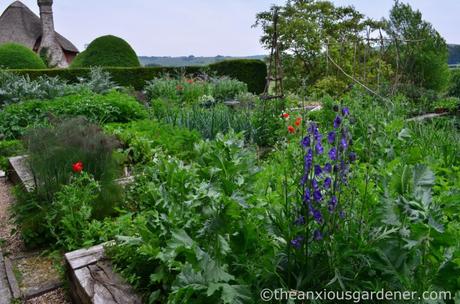
I liked the vegetable garden very much but as much as I’m relaxed about poisonous aconitum, I might balk at it flowering in a kitchen garden. Pretty blue flowers on that salad, anyone?
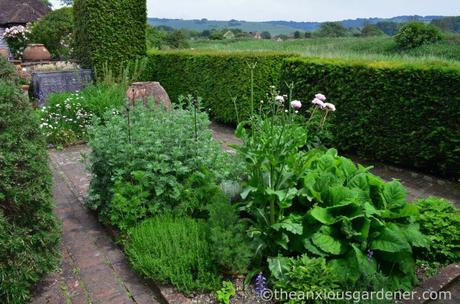
I retraced my steps to a small brick-paved area, with a central bed and peony in flower, to views over the yew hedging, across the river valley with the Downs beyond.
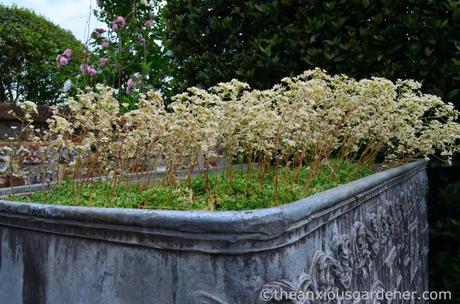
A massive container should hold huge plants, shouldn’t it?
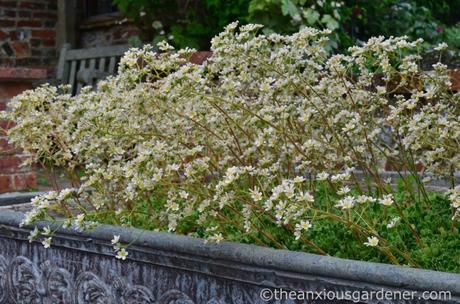
Well, no actually. Not if filled with something as pretty as this saxifrage (which I think is Saxifraga ‘Esther’).
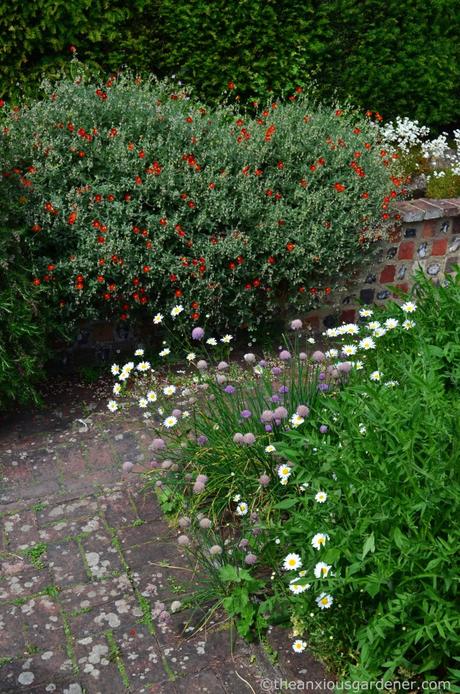
Nearby, relishing the southerly aspect, was a very impressive helianthemum.
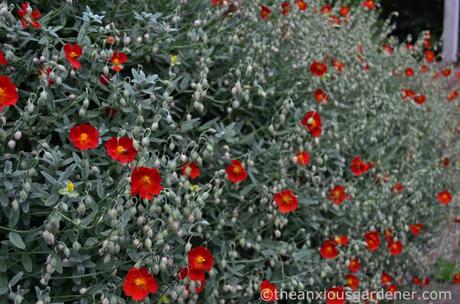
When I worked in an alpine nursery, I knew these as scraggly, little plants in 3″ pots. How marvelous to see it as a huge, established specimen.
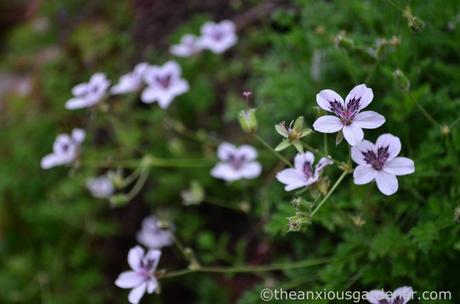
And close by are erodiums. This one looks like Erodium x kolbianum ‘Natasha’ but I don’t think it is. Anyone?
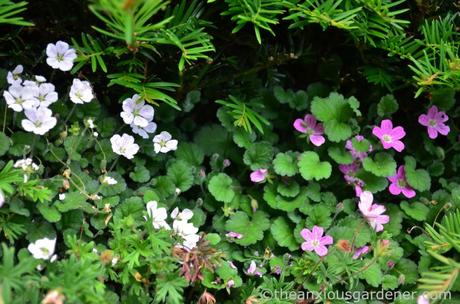
Two more erodiums peeped out from under the yew. I do know these but, for no good reason, I don’t grow them: both the very pretty Erodium × variabile ‘Album’ and the pink, Erodium × variabile ‘Bishop’s Form’ suppress weeds and flower from spring to autumn. Find space.
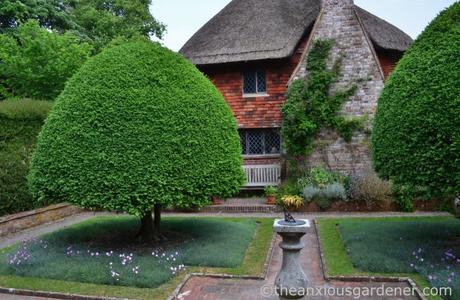
Four clipped yew trees sit near the west wall of the house, under-planted with dianthus.
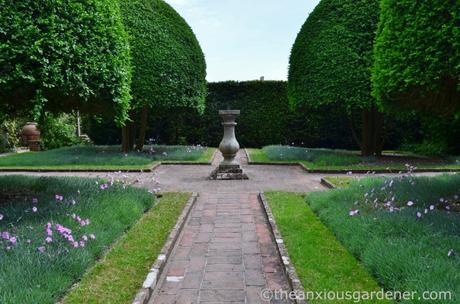
These pinks were just coming into flower during my visit but will be a sight – and scent – a little later on.
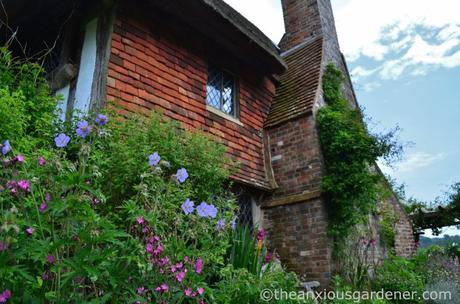
Red campion, blue geraniums and magenta gladioli jostle against the house wall
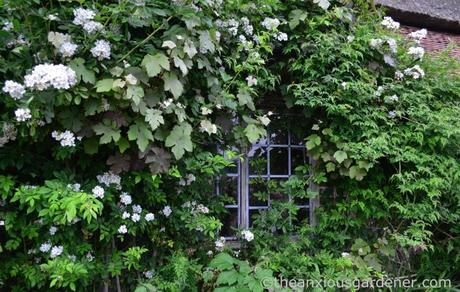
with white rambling rose, summer jasmine and vine racing to obscure windows.
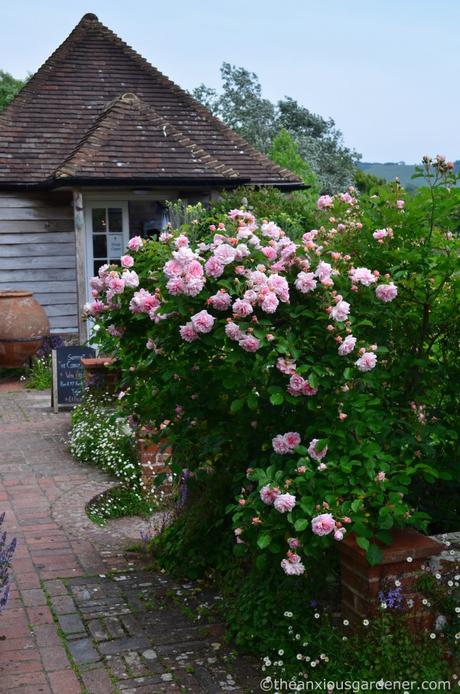
And so back, through a cloud of rose perfume, to the ticket office
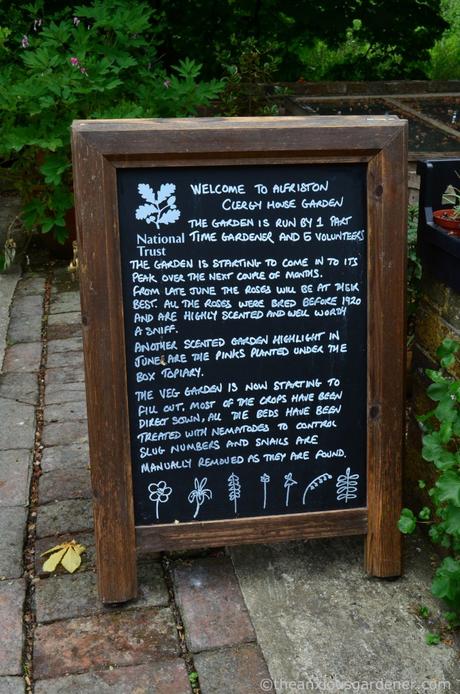
and the blackboard. I’m always interested to see how much work goes into making a garden and appreciated this easy to do, yet often missing, extra detail from the team.
I turned to enter the house but, though the garden was mostly empty, it was too busy with the door blocked by visitors waiting to get in. I decided to come back on another day (and chalk up another £5.35). My brain mulling over gardening ideas and inspiration, I returned to the entrance gate (avoiding the plants-for-sale with steely willpower) and walked out to the Church.
Right then, time enough for The George Inn and that pint of Harveys.
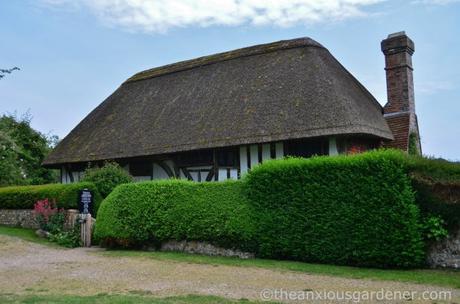
The Clergy House is open mainly from March through to the end of October (but not Thursdays and Fridays. Check detailed opening hours here). There is no parking near the property, so if you’re driving, leave your car in one of the village car-parks and walk along the High Street and down to the church. Alternatively, take the train to Seaford and follow a grand walk to Alfriston (two or three hours). The Clergy House has a shop if no tea-room but there are plenty of cafés, and those pubs, in the village.
*I’ve recently learnt that I’ve been mispronouncing the name of the village. Wow the villagers with your local knowledge and say it right – ALLfriston.
oooOOOooo
January has been a busy time for my blog. It featured in Gardener’s World Magazine as one of ’50 New Things To Try’; and it was also recommended as one of six gardening blogs to follow in an article by Rachel de Thame for The Sunday Times. (Photos of both articles are on my ‘As Featured In’ page).
In addition, I’ve answered questions posed by a couple of websites. The first, for Capital Gardens, was about New Year’s resolutions. The second, for Garden Buildings Direct, on the health benefits of gardening. Click the links to read answers from me and other garden bloggers.
Save
Save
Save
Save
Save
Save
Save
Save
Save
Save
Save
Save
Save
Save
Save
Save
Save
Save

